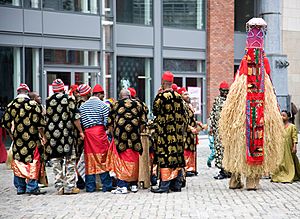New Yam Festival of the Igbo facts for kids
The New Yam Festival is a special yearly celebration for the Igbo people of Nigeria. It's also known by names like Iwa ji, Iri ji, Ike ji, or Otute, depending on the local dialect. This festival happens at the end of the rainy season, usually in early August. It's a time to celebrate the new yam harvest and thank the gods for a good farming year.
The Iri ji festival, which means "new-yam eating," is celebrated in many parts of West Africa, especially in Nigeria and Ghana. It marks the end of one farming season and the start of the next. This celebration is very important for Igbo communities. It shows how much they depend on yams, which they call the "king of crops."
Why Yams Are So Important
Yams are one of the first crops planted when the farming season begins. Between April and August, other crops like maize (corn), cocoyams, and pumpkins are harvested. People eat these without much fuss. But the New Yam Festival is a big event because it highlights how important yams are to the Igbo way of life.
In some Igbo communities, people must eat or throw away all their old yams from the previous year before the festival starts. On the day of the festival, only dishes made from new yams are served. This shows how much new yams are celebrated and how plentiful the harvest is.
Even though different communities might celebrate in slightly different ways, the main parts of the festival stay the same. Some celebrations last just one day, while others can go on for a week or more. These events usually include fun activities and special ceremonies. The Igwe (King) or the oldest man in the community often performs important rituals. There are also cultural dances by Igbo men, women, and children. The festival is full of Igbo culture, with modern shows, exciting masquerade dances, and even fashion parades.
The Ịwa-ji Ceremony
The festival usually begins with a special ceremony where yams are offered to the gods and ancestors. After this, the yams are shared with everyone in the village. The oldest man in the community, or sometimes the king or a respected leader, performs this ritual. He thanks the supreme deity for protecting them and helping them through difficult times to a time of plenty without hunger.
After this prayer of thanks, they eat the first yam. People believe that these leaders can connect with the gods of the land. The rituals show the community's thanks to the gods for making the harvest possible. These traditions are still widely followed, even with the influence of Christianity in the area. This shows that the Igbo people are practical, religious, and grateful.
The festival day is a time for enjoyment after the hard work of farming. People share their abundance with friends and visitors. Many fun activities happen during the new yam eating. There are folk dances, amazing masquerades, lively parades, and parties. Many people describe the colorful festival as a form of "art." It's a wonderful display of joy, thanks, and community spirit.
The yam used for the main ritual is usually roasted and served with palm oil (called mmanụ nri). The Iwa ji festival is similar to the Asian Mid-Autumn Festival in some ways. Both are based on the cycles of the moon and are community harvest festivals.
This event is very important for Igbo people all around the world. The yam harvest and the festival celebrating the gods show the people's strong belief in a supreme deity. When the new moon appears in August, it signals the start of preparations for the great "Iri Ji Ohu" festival. However, the exact timing and way of preparing for it can differ from one community to another.
The New Yam festival is a truly captivating art event. It's a colorful show of unity, dance, joy, and feasting. It's an annual celebration for community members to mark the end of the farming season. During this festival, people express their thanks to everyone who helped them have a great harvest.
Images for kids
See also
 In Spanish: Festival igbo del nuevo ñame para niños
In Spanish: Festival igbo del nuevo ñame para niños







